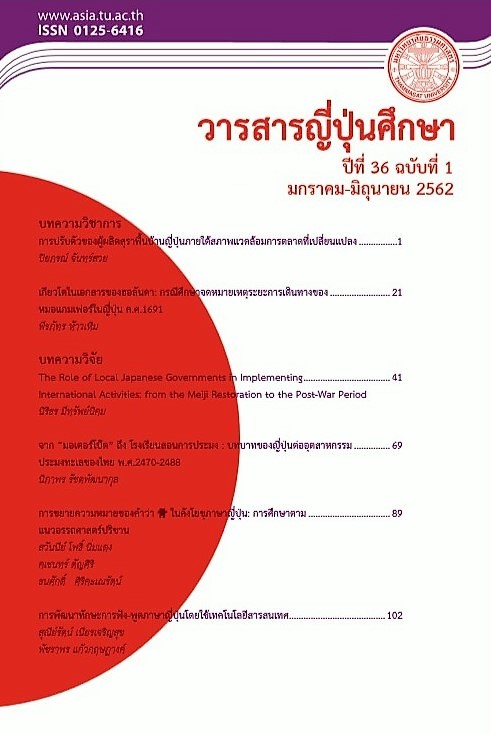Kyoto in the Document of the Hollanda: A case study of the Travel Records of Doctor Kaempfer in Japan, 1691
Keywords:
Kyoto, Hollanda, Travel Record, Engelbert Kaempfer, JapanAbstract
This article aims to study the context of Kyoto in attitudes and perceptions of Doctor Kaempfer, as it appears in the 1691 Travel Record. The study found that (1) The Travel Record it is an important historical document reflecting the thinking and point of view that foreigners have understanding Japan, especially Kyoto, which has a special status than Osaka and Edo. (2) The Kaempfer Record gives some observations about the author of the book Arnoldus Montanus, "Ambassades Mémorables De La Compagnie des Indes Orientales Des Provinces Unies Vers Les Empereurs Du Japon," It was written by the study of the records of the East India Company of the Netherlands (VOC, Hollanda), Which never traveled to Japan. (3) the travels Record of Doctor Kaempfer, makes understand the context of Japan and Kyoto in the late 17th century. Which has contacted marine trade in East Asia. Although the Shogun government has a policy of closing the country, it gives foreigners the opportunity to trade with Japan. This presentation of Kyoto illustrates the importance of Kyoto as a center of religious, social, economic and cultural. At present, Kyoto has attracted many tourists from Thailand and foreigners. The dissemination of this information will help to understand the context of Kyoto over 300 years ago, how Western travelers perceived Kyoto as compared to the present. It also helps to understand the status of Japanese society in the late seventeenth century more. In summary, the travels Record of Doctor Kaempfer are historical documents that use descriptive writing methods that apply knowledge Diversity such as the use of medical, geography, forestry, liberal arts, and archeology. And is a historical document that has benefits to learning Japan and reflects the being of Japanese society. In the attitude and perception. Of the most valuable foreigners.
Downloads
References
ดวงจันทร์ เจริญเมือง และคณะฯ. (2541). รายงานการวิจัยฉบับสมบูรณ์การผังเมืองเกียวโตและนารา: บทเรียนสำหรับเชียงใหม่. กรุงเทพฯ: สำนักงานคณะกรรมการวิจัยแห่งชาติ.
นิธิ เอียวศรีวงศ์. (2547). เกียวโตใต้ ชะเงื้อมดอยสุเทพ. พิมพ์ครั้งที่ 2. กรุงเทพฯ: มติชน.
พิพาดา ยังเจริญ. (2546). จักรพรรดิ ขุนนาง นักรบ และพ่อค้าในสังคมญี่ปุ่นก่อนสมัยใหม่. กรุงเทพฯ: สำนักพิมพ์แห่งจุฬาลงกรณ์มหาวิทยาลัย.
พีรภัทร ห้าวเหิม. (2561). เกียวโต ประวัติศาสตร์พันปี. กรุงเทพฯ: ยิปซี.
อัมพร สายสุวรรณ. (2545). ไทยในจดหมายเหตุแกมเฟอร์. พิมพ์ครั้งที่ 5. กรุงเทพฯ: กรมศิลปากร.
เอ็ดวิน โอ. ไรเชาเออร์. (2534). ญี่ปุ่น. พิมพ์ครั้งที่ 2. วุฒิชัย มูลศิลป์, สุภัทรา วรรณนิณ บรรณาธิการ. กรุงเทพฯ: ไทยวัฒนาพานิช.
Arnoldus Montanus. (1680) Ambassades Mémorables De La Compagnie Des Indes Orientales Des Provinces Unies Vers Les Empereurs Du Japon. Amsterdam: Jacob De Meurs.
Beatrice M. Bodart-Bailey and Derek Massarella. (1995). The Furthest Goal: Engelbert Kaempfers Encounter with Tokugawa Japan. London: Routledge.
Beatrice M. Bodart-Bailey. (1992). The Most Magnificent Monastery and Other Famous Sights: The Japanese Painting of Engellbert Kaempfer. Japan Review, 3: 25-44.
Engellbert Kaempfer, John Gasper Scheuchzer (1727). The History of Japan Vol 1. London: n.p.
Engellbert Kaempfer, John Gasper Scheuchzer. (1727). The History of Japan Vol 2. London: n.p.
Engellbert Kaempfer. (1999). Kaempfer’s Japan, Tokugawa Culture Observed. Beatrice M. Bodart- Bailey, Edited, Translated. Honolulu: University of Hawai’i Press.
Herbert E, Plustchow. (1986). Historical Kyoto. Tokyo: The Japan Times, Ltd., Second Printing.
Japanese Historical Maps. (2018). Japan Reyskaart. Retrieved from https://goo.gl/PBEkLq
Marius B. Jansen. (2002). Making of Modern Japan. Cambridge, Massachusetts: Harvard University Press., Third Printing
Matsuda Koichiro. (2016). Japan and the Pacific, 1540–1920, Threat and Opportunity. London: Routledge.
Matthew Stavros and Norika Kurioka. (2015). "Imperial Progress to the Muromachi Palace, 1381 A Study and Annotated Translation of Sakayuku Hana". Japan Review 28, 3–46.
Matthew Stavros. (2014). Kyoto an Urban History of Japan’s Premodern Capital. Honolulu: University of Hawai’i Press.
Max Meulendijks. (2014). Kaempfers Lessons from Japan – Using Tokugawa Regulation for Educating Europe. MaRBle Reasearch Papers, Maastricht University, Vol.6, pp. 135 - 153.
Michel, Wolfgang. (2018). Engelbert Kaempfer and Imamura Eisei. Retrieved from https://goo.gl/tYkacV
Michel, Wolfgang. "On Engelbert Kaempfer's "Ginkgo" (revised version)". Kyushu University. Archived from the original on 7 October 2011. Retrieved from 1 December 2018.
Michel, Wolfgang. "Glimpses of medicine and pharmaceutics in early Japanese-German intercourse," in International Medical Society of Japan (ed.): The Dawn of Modern Japanese Medicine and Pharmaceuticals – The 150th Anniversary Edition of Japan-German Exchange. Tokyo 2011, pp. 72– 94.
Nakai Nobuhiko and McClain, J.L. (1991). Commercial Change and Urban Growth in Early Modern Japan. In J.W. Hall et al (eds.), The Cambridge History of Japan. Vol.4, pp. 519-595. Cambridge: Cambridge University Press.
National Graduate Institute for Policy Studies. (2018). Edo Period, Pre-conditions for Industrialization. Retrieved from http://www.grips.ac.jp/teacher/oono/hp/lecture_J/lec02.htm




